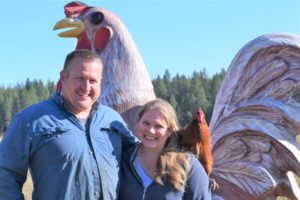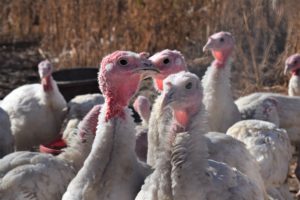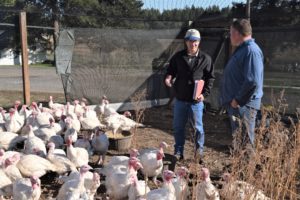
Allen and Emmy Widman manage a chicken layer flock and raise several hundred broiler chickens and turkeys.
By Gina Kerzman, USDA
Allen and Emmy Widman, of Palouse Pasture Poultry in Rosalia, Washington, raise annual grain crops, manage a chicken layer flock, and raise several hundred broiler chickens and turkeys for Thanksgiving.
Season to Season
The Widmans built a Washington State Department of Agriculture-licensed processing plant, one of the only plants left in Eastern Washington.
The family raises poultry during the warmer months of the year. Turkeys, which average around 15 pounds each, are available in November and December. This year, they raised over 300 turkeys.
“We process the turkeys ourselves here on the farm and sell them all fresh,” says Allen. “Between fall seeding and field work, processing and marketing turkeys, and keeping up with daily egg production, not to mention our kids’ sports schedules, there is never a minute to lose near Thanksgiving.”
While the crops and turkeys are seasonal, egg production is a daily affair. About three-quarters of Palouse Pastured Poultry eggs are sold in Seattle and the Puget Sound area, and the rest are sold locally in Spokane.
“We ship 120 to 130 cases of eggs a week with 12 dozen to a case,” says Allen.
The Widman’s three children help with gathering or packing eggs on the weekends, during the summer or whenever they are needed.

The Widmans process the turkeys on the farm and sell them all fresh.
Growing the Farm
The Widmans are long-time customers of USDA’s Natural Resources Conservation Service and Farm Service Agency.
When starting their business, they participated in FSA’s farm loan programs as beginning farmers.
These loan programs offer direct and guaranteed loans to farmers and ranchers to promote, build, and sustain family farms for a thriving agricultural economy.
While operating loans have assisted Allen and Emmy with annual financing and equipment, farm ownership loans have helped them to purchase land.
Conserving Natural Resources
The Widmans have nearly two miles of riparian buffer along a creek on their operation enrolled in the Conservation Reserve Program in which landowners remove environmentally sensitive land from agricultural production and plant species that will improve environmental health and quality.

The Widman’s implement a variety of conservation practices on their farm with assistance from FSA and NRCS.
Working with NRCS, they have implemented a residue management system through the Environmental Quality Incentives Program by using the practice “mulch till” to manage the amount, orientation, and distribution of crop and other plant residue on the soil surface while limiting the soil-disturbing activities.
This helps reduce soil erosion and improve soil health. On poultry grazing areas, they installed electric netting, cross fencing, watering facilities, and a prescribed grazing system to rotate grazing and improve plant health and vigor. They also enhanced wildlife habitat on their farm by planting 0.5 acres of trees and shrubs for wildlife.
“It’s been a huge help,” says Allen. “We wouldn’t be doing this without FSA and NRCS.”
More Information
USDA offers a variety of risk management, disaster assistance, loan, and conservation
programs to help agricultural producers in the United States weather ups and downs in the market and recover from natural disasters as well as invest in improvements to their operations. Learn about additional programs.
For more information about USDA programs and services, contact your local USDA service center.
For an interactive version of this blog, visit #FridaysOnTheFarm.





